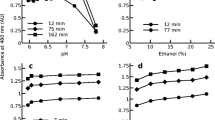Abstract
In the metabolism of chromium(VI) its reduction in human plasma is of importance; an extracellular reduction of Cr(VI) is regarded as a detoxification step. Ascorbic acid has been suggested to represent the majority of the Cr(VI)-reducing capacity of human plasma. Therefore the kinetics of the reaction of Cr(VI) with ascorbic acid, at biologically realistic concentrations were studied. Ascorbic acid, in 0.2 M HEPES buffer and at concentrations ranging from 14.2 to 113.6 nmol ml−1 (2.5–20.0 μg ml−1), was mixed with Cr(VI) (0.4–1.5 nmol ml−1) and incubated at pH 7.4 and 37° C. In addition, chromate solutions at different concentrations [1.5–100 nmol ml−1 Cr(VI)], were incubated at 37° C with freshly drawn blood. From these incubates, ascorbic acid and its oxidized form, dehydroascorbic acid, were simultaneously analyzed by HPLC and post-column derivatization. Chromate was determined by flow injection analysis. The reaction kinetics of ascorbic acid in HEPES buffer with Cr(VI) is of pseudofirst order at higher concentrations, whilst apparently at lower concentrations kinetics are consistent with an autocatalyzed reaction. Results obtained after spiking human plasma are similar. However, when Cr(VI) was reacted with human plasma, no changes in the intrinsic contents of ascorbic acid of the plasma samples occurred. Also, comparing different plasma samples the intrinsic plasma contents of ascorbic acid and the reduction capacities for Cr(VI) [ranging between 0.48 and 0.63 nmol ml−1 Cr(VI) to be reduced] did not correlate. This shows that the reduction of Cr(VI) in native human plasma is complex and is not only determined by the plasma ascorbic acid levels. This is in contrast to the situation in lung lavage fluids (Suzuki 1988; Suzuki and Fukuda 1990) where the concentrations of ascorbic acid are much higher than in blood.
Similar content being viewed by others
References
Borges KM, Boswell JS, Liebross RH, Wetterhahn KE (1991) Activation of chromium(VI) by thiols results in chromium(V) formation, chromium binding to DNA and altered DNA conformation. Carcinogenesis 12: 551–561
Branca M, Dessi A, Kozlowski H, Micera G, Serra MV (1989) In vitro interaction of mutagenic chromium(VI) with red blood cells. FEBS Lett 257: 52–54
Connett PH, Wetterhahn KE (1985) In vitro reaction of the carcinogen chromate with cellular thiols and carboxylic acids. J Am Chem Soc 7: 4282–4288
Deutsche Forschungsgemeinschaft (1990) Henschler D, Lehnert G (eds) Biologische Arbeitsstoff-Toleranz-Werte (BAT-Werte), Arbeitsmedizinisch toxikologische Begründungen. Verlag Chemie, Weinheim, Vol. 1, Alkalichromate-(VI), pp 1–19
Ibric LLV, Benedict WF, Peterson AR (1988) Simultaneous determination of ascorbic acid and dehydroascorbic acid in cultures of C3H/10T1/2 cells. In Vitro Cell Dev Biol 24: 669–676
Korallus U, Harzdorf C, Lewalter J (1984) Experimental bases for ascorbic acid therapy of poisoning by hexavalent chromium compounds. Int Arch Occup Environ Health 53: 247–256
Laryea MD, Biggemann B, Cieslicki P, Wendel U (1989) Plasma tocopherol and tocopherol to lipid ratios in a normal population of infants and children. Int J Vitam Nutr Res 59: 269–272
Lewalter J, Korallus U (1988) Zur Bedeutung von Ascorbinsäure und Glutathion für den Chromat-Stoffwechsel beim Menschen. Verh Dtsch Ges Arbeitsmedizin 28: 327–333
Lewalter J, Korallus U (1989) The significance of ascorbic acid and glutathione for chromate metabolism in man. Toxicol Environ Chem 24: 25–33
Lewalter J, Korallus U, Harzdorf C, Weidemann H (1985) Chromium bond detection in isolated erythrocytes: a new principle of biological monitoring of exposure to hexavalent chromium. Int Arch Occup Environ Health 55: 305–308
Lopez-Anaya A, Mayersohn M (1987) Ascorbic and dehydroascorbic acid simultaneously quantified in biological fluids by liquid chromatography with fluorescence detection, and comparison with a colorimetric assey. Clin Chem 33: 1874–1878
Neidhart B, Backes U (1989) Reverse FIA for on-line determination of chromate in the aqueous environment. In: Vernet JP (ed) Heavy metals in the environment. International Conference Geneva, Vol. 1, pp 598–601
Ryberg D, Alexander J (1990) Mechanisms of chromium toxicity in mitochondria. Chem Biol Interact 75: 141–151
Suzuki Y (1988) Reduction of hexavalent chromium by ascorbic acid in rat lung lavage fluid. Arch Toxicol 62: 116–122
Suzuki Y, Fukuda K (1990) Reduction of hexavalent chromium by ascorbic acid and glutathione with special reference to the rat lung. Arch Toxicol 64: 169–176
Wada O, Manabe W, Yamaguchi N, Ishikawa S, Yanagisawa H (1983) Low molecular-weight, chromium-binding substance in rat lungs and its possible role in chromium movement. Ind Health 21: 35–41
Wetterhahn KE, Hamilton JW, Aiyar J, Borges KM, Floyd R (1989) Mechanism of chromium(VI) carcinogenesis, reactive intermediates and effect on gene expression. Biol Trace Element Res 21: 405–411
Wiegand HJ, Ottenwälder H, Bolt HM (1985) The formation of glutath one chromium complexes and their possible role in chromium dis position. Arch Toxicol Suppl 8: 319–321
World Health Organisation, International Agency for Research of Cancer (1980) IARC monography on the evaluation of the carcino genic risk of chemicals to humans — some metals and metallic compounds. IARC, Lyon, Vol. 23: 205–325
Yamamoto A, Wada O, Manabe S (1989) Evidence that chromium is a essential factor for biological activity of low-molecular-weight, chro mium binding substance. Biochem Biophys Res Commun 16: 189–193
Author information
Authors and Affiliations
Rights and permissions
About this article
Cite this article
Capellmann, M., Bolt, H.M. Chromium (VI) reducing capacity of ascorbic acid and of human plasma in vitro. Arch Toxicol 66, 45–50 (1992). https://doi.org/10.1007/BF02307269
Received:
Accepted:
Issue Date:
DOI: https://doi.org/10.1007/BF02307269




